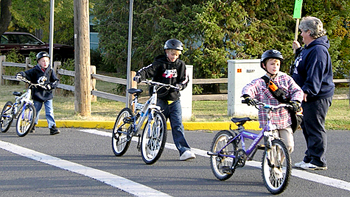
| CONNECTIONS |
IDAHO
ITD
HOME
511 TRAVEL SERVICES
IDAHO
DMV
ITD
NEWS
HIGHWAY
SAFETY
IDAHO STATE POLICE
STATE OF IDAHO
NIATT
NATIONAL
AASHTO
AAMVA
AAA of IDAHO
FEDERAL HIGHWAYS
FEDERAL AVIATION
IDAHO STATE POLICE
NHTSA
NTSB
TRB
U.S. DOT
TRANSPORTER
Archives
Milestones
Comments
Idaho
Transportation
Department
Office of Communications
P.O. Box 7129
Boise, ID 83707
208.334.8005
Fax: 208.334.8563

Children, motorists urged to use caution
as schools reopen throughout Idaho
Bicycle paths, sidewalks and school playgrounds will return to life as children throughout Idaho head back to class this fall. The corresponding increase in traffic near schools will require that drivers and children use extreme caution during the morning and afternoon commutes
ITD joins public and private partners statewide in urging motorists to use caution in areas where children are likely to be present, both during school hours and school commutes.
Many of Idaho’s school zones are identified by flashing yellow lights when children likely will be present.
 Drivers who fail to slow down to school zone speeds (generally 20 mph) will pay a heavier price this year as a result of 2008 legislation that mandates a minimum fine of $75, plus $41.50 in court costs, for violators. Local governments can make speeding penalties even higher for school zones within their jurisdictions.
Drivers who fail to slow down to school zone speeds (generally 20 mph) will pay a heavier price this year as a result of 2008 legislation that mandates a minimum fine of $75, plus $41.50 in court costs, for violators. Local governments can make speeding penalties even higher for school zones within their jurisdictions.
Unless otherwise posted, school zone speed limits do not apply on non-school days. Speed limit signs indicate the school zone, the reduced speed limit and one of the following:
-
Hours of the day when the speed limit is in effect
-
That the speed limit is in effect when an electrical or mechanical signal indicates or
-
That the speed limit is in effect at all times on school days.
Some schools also use crossing guards at intersections. Motorists are required to slow or stop as the guards dictate.
Motorists who have grown accustomed to sailing undeterred through the zones the past three months will need to renew their vigilance. They also will need to watch for inattentive children stepping from curbs, meandering bicycles straying into the traffic lane and buses stopped for student loading and unloading.
School children also share a greater responsibility to be aware of increased traffic along primary school routes. They should watch for distracted drivers and anticipate that cars may not slow for flashing lights or crossing guards.
Awareness and anticipation are keys to ensuring the next nine months are free of casualties and enabling children and vehicles to coexist safely.
To reduce the risk that children face on their journey to and from school, ITD has created an ambitious Safe Routes to school program. It provides grant funds for infrastructure improvements and educational and incentive programs to local school districts, cities, counties and highway districts.
Many improvements to bicycle and pedestrian paths, crosswalks and crossing signs already have been completed. Others are in the process. Educational programs also are being designed in many school districts to prepare children for safe travel to schools.
“This is always an exciting time of year for children. School shopping is done and kids are anxious to get back together with classmates they haven’t seen since spring,” said Josephine O’Connor, coordinator of the statewide Safe Routes to School program. “Too often, (children) are preoccupied by that excitement, and the last things on their minds are the hazards associated with traffic.
“Children tend to act impulsively, often are less aware of their surroundings and are easily distracted. That can be a dangerous combination. Our best advice, for motorists and children alike is to slow down and be aware of your surroundings. Drivers should look for distracted children and children should watch for distracted drivers.”
Published 8-22-8